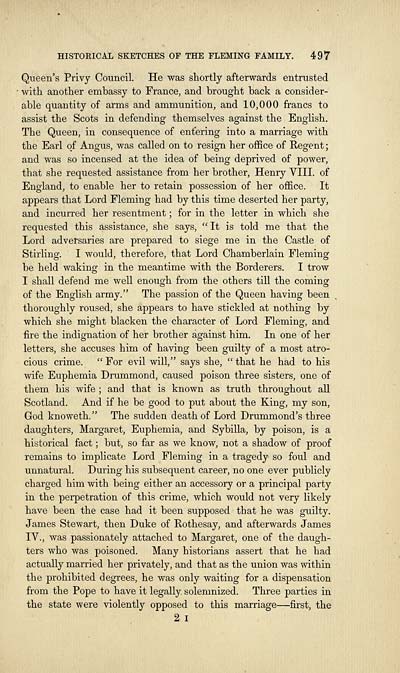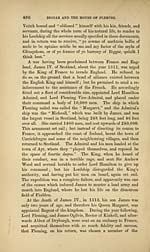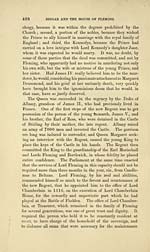Biggar and the House of Fleming
(527) Page 509
Download files
Complete book:
Individual page:
Thumbnail gallery: Grid view | List view

HISTORICAL SKETCHES OF THE FLEMING FAMILY. 497
Queen's Privy Council. He was shortly afterwards entrusted
with another embassy to France, and brought back a consider-
able quantity of arms and ammunition, and 10,000 francs to
assist the Scots in defending themselves against the English.
The Queen, in consequence of entering into a marriage with
the Earl of Angus, was called on to resign her office of Regent ;
and was so incensed at the idea of being deprived of power,
that she requested assistance from her brother, Henry VIII. of
England, to enable her to retain possession of her office. It
appears that Lord Fleming had by this time deserted her party,
and incurred her resentment ; for in the letter in which she
requested this assistance, she says, "It is told me that the
Lord adversaries are prepared to siege me in the Castle of
Stirling. I would, therefore, that Lord Chamberlain Fleming
be held waking in the meantime with the Borderers. I trow
I shall defend me well enough from the others till the coming
of the English army." The passion of the Queen having been
thoroughly roused, she appears to have stickled at nothing by
which she might blacken the character of Lord Fleming, and
fire the indignation of her brother against him. In one of her
letters, she accuses him of having been guilty of a most atro-
cious crime. "For evil will," says she, "that he had to his
wife Euphemia Drummond, caused poison three sisters, one of
them his wife ; and that is known as truth throughout all
Scotland. And if he be good to put about the King, my son,
God knoweth." The sudden death of Lord Drummond's three
daughters, Margaret, Euphemia, and Sybilla, by poison, is a
historical fact ; but, so far as we know, not a shadow of proof
remains to implicate Lord Fleming in a tragedy so foul and
unnatural. During his subsequent career, no one ever publicly
charged him with being either an accessory or a principal party
in the perpetration of this crime, which would not very likely
have been the case had it been supposed that he was guilty.
James Stewart, then Duke of Rothesay, and afterwards James
IV., was passionately attached to Margaret, one of the daugh-
ters who was poisoned. Many historians assert that he had
actually married her privately, and that as the union was within
the prohibited degrees, he was only waiting for a dispensation
from the Pope to have it legally solemnized. Three parties in
the state were violently opposed to this marriage — first, the
2 I
Queen's Privy Council. He was shortly afterwards entrusted
with another embassy to France, and brought back a consider-
able quantity of arms and ammunition, and 10,000 francs to
assist the Scots in defending themselves against the English.
The Queen, in consequence of entering into a marriage with
the Earl of Angus, was called on to resign her office of Regent ;
and was so incensed at the idea of being deprived of power,
that she requested assistance from her brother, Henry VIII. of
England, to enable her to retain possession of her office. It
appears that Lord Fleming had by this time deserted her party,
and incurred her resentment ; for in the letter in which she
requested this assistance, she says, "It is told me that the
Lord adversaries are prepared to siege me in the Castle of
Stirling. I would, therefore, that Lord Chamberlain Fleming
be held waking in the meantime with the Borderers. I trow
I shall defend me well enough from the others till the coming
of the English army." The passion of the Queen having been
thoroughly roused, she appears to have stickled at nothing by
which she might blacken the character of Lord Fleming, and
fire the indignation of her brother against him. In one of her
letters, she accuses him of having been guilty of a most atro-
cious crime. "For evil will," says she, "that he had to his
wife Euphemia Drummond, caused poison three sisters, one of
them his wife ; and that is known as truth throughout all
Scotland. And if he be good to put about the King, my son,
God knoweth." The sudden death of Lord Drummond's three
daughters, Margaret, Euphemia, and Sybilla, by poison, is a
historical fact ; but, so far as we know, not a shadow of proof
remains to implicate Lord Fleming in a tragedy so foul and
unnatural. During his subsequent career, no one ever publicly
charged him with being either an accessory or a principal party
in the perpetration of this crime, which would not very likely
have been the case had it been supposed that he was guilty.
James Stewart, then Duke of Rothesay, and afterwards James
IV., was passionately attached to Margaret, one of the daugh-
ters who was poisoned. Many historians assert that he had
actually married her privately, and that as the union was within
the prohibited degrees, he was only waiting for a dispensation
from the Pope to have it legally solemnized. Three parties in
the state were violently opposed to this marriage — first, the
2 I
Set display mode to:
![]() Universal Viewer |
Universal Viewer | ![]() Mirador |
Large image | Transcription
Mirador |
Large image | Transcription
Images and transcriptions on this page, including medium image downloads, may be used under the Creative Commons Attribution 4.0 International Licence unless otherwise stated. ![]()
| Histories of Scottish families > Biggar and the House of Fleming > (527) Page 509 |
|---|
| Permanent URL | https://digital.nls.uk/94845606 |
|---|
| Description | A selection of almost 400 printed items relating to the history of Scottish families, mostly dating from the 19th and early 20th centuries. Includes memoirs, genealogies and clan histories, with a few produced by emigrant families. The earliest family history goes back to AD 916. |
|---|

